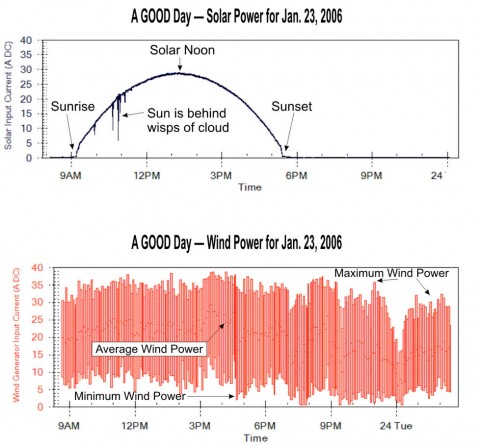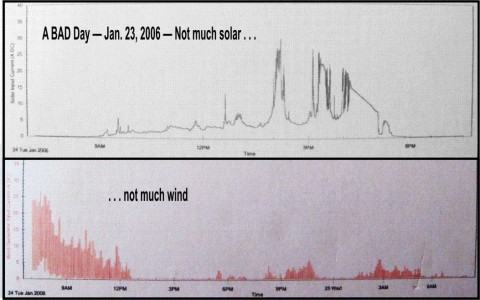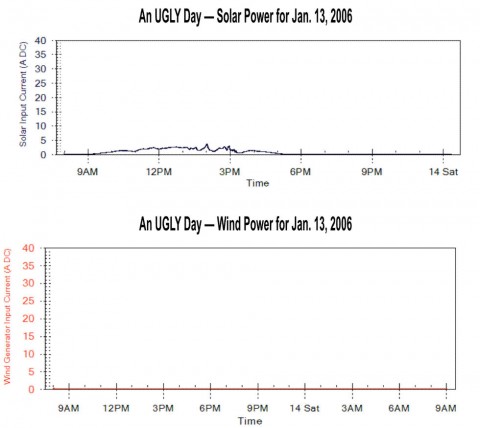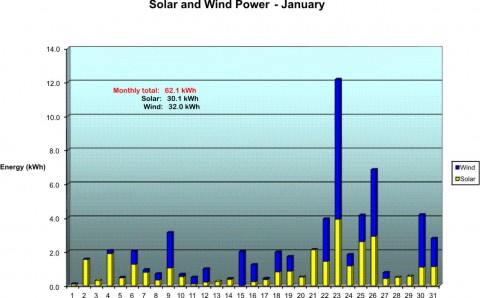Living in an Off-Grid Solar House - The Good, the Bad, and the Ugly
I built my off-grid solar home with my husband in 2003. The house was originally powered by a combination of solar and wind power. Living off-grid is an interesting experience. Everything you do - cook lunch, have a shower, watch TV - it's all powered by the sun or the wind. A pretty cool feeling - most of the time. Let me introduce you to the GOOD, the BAD and the UGLY.
We experienced them all one January in 2006. January 23 was clear and cold. A bitter wind raged through the bare trees and whipped the snow into eddies and drifts. But for us, it was still a good day because the sunshine and horrendous winds gave us a record day for power. Not all days are like that.
This is what that a good day looks like to us:

A Good Day for Solar and Wind Power
You can see the sun rise in the first chart, see it start to produce more and more power until solar noon, then decrease again till sunset - a nice uniform curve. The jagged dips are from wisps of cloud crossing the face of the sun. The second chart shows the wind power - it is recorded in short intervals and what you see here in red is the maximum and minimum power for each interval, with a line in the middle for the average. You can see how variable the wind is, compared to the solar - it's not the steady line or curve that you might expect.
That night the wind started to die down and the next day started out cloudy, with some clear sky later in the day.

A Bad Day for Solar and Wind
But this is not the worst it can get. Imagine a day with no wind and it's snowing. Here it is - the UGLY day.

An Ugly Day for Solar and Wind
Fortunately, we don't see many days like this - but notice, there is still some solar power, even when it's snowing. It is for days like this that an off-grid system has a large battery bank to see you through. In January, however, that may not be enough to carry you through all the bad and ugly days so a backup generator is also part of the system.
This is what the whole month of January can look like (2006 had an unusually cloudy January).

Our Solar and Wind Power for January 2006
The yellow bars show the solar power we received, and the blue bars represent the wind power. Add the two together and you have the total power. You can see January 23, the GOOD day, as a very tall bar - we produced 12 kWh of power that day. We only need 5 kWh a day to run our house so we stored the extra in our batteries. The next day was the BAD day - you can see how short that bar is in the chart. The UGLY day was January 13 - a very short bar indeed.
This was the worst month of the year. Most months there is plenty of sun and wind to supply all the needs of our home. That is the story with off-grid homes - you can store power for a few days, but there is no way to store all the extra power from the summer for months like this. That is the big difference between off-grid and grid-tied systems. Grid-tied systems are connected to the utility grid and, where net metering is offered, you can use the utility grid to "store" excess power that you produce in the summer for the winter months. This is done by giving you credits on your bills for the extra power.
As I am writing this, we are having one of those ugly days. Our wind turbine is not turning and we are having our first snowfall of the season. But it's been a long and beautiful summer and fall. Like farmers, we have to work with the vagaries of the weather, but we enjoy the rewards of being self sufficient, environmentally friendly and never having a power outage.